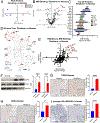Combined CDK4/6 and ERK1/2 Inhibition Enhances Antitumor Activity in NF1-Associated Plexiform Neurofibroma
- PMID: 37406085
- PMCID: PMC11060649
- DOI: 10.1158/1078-0432.CCR-22-2854
Combined CDK4/6 and ERK1/2 Inhibition Enhances Antitumor Activity in NF1-Associated Plexiform Neurofibroma
Erratum in
-
Correction: Combined CDK4/6 and ERK1/2 Inhibition Enhances Antitumor Activity in NF1-Associated Plexiform Neurofibroma.Clin Cancer Res. 2024 May 1;30(9):1992. doi: 10.1158/1078-0432.CCR-24-0635. Clin Cancer Res. 2024. PMID: 38690594 No abstract available.
Abstract
Purpose: Plexiform neurofibromas (PNF) are peripheral nerve sheath tumors that cause significant morbidity in persons with neurofibromatosis type 1 (NF1), yet treatment options remain limited. To identify novel therapeutic targets for PNF, we applied an integrated multi-omic approach to quantitatively profile kinome enrichment in a mouse model that has predicted therapeutic responses in clinical trials for NF1-associated PNF with high fidelity.
Experimental design: Utilizing RNA sequencing combined with chemical proteomic profiling of the functionally enriched kinome using multiplexed inhibitor beads coupled with mass spectrometry, we identified molecular signatures predictive of response to CDK4/6 and RAS/MAPK pathway inhibition in PNF. Informed by these results, we evaluated the efficacy of the CDK4/6 inhibitor, abemaciclib, and the ERK1/2 inhibitor, LY3214996, alone and in combination in reducing PNF tumor burden in Nf1flox/flox;PostnCre mice.
Results: Converging signatures of CDK4/6 and RAS/MAPK pathway activation were identified within the transcriptome and kinome that were conserved in both murine and human PNF. We observed robust additivity of the CDK4/6 inhibitor, abemaciclib, in combination with the ERK1/2 inhibitor, LY3214996, in murine and human NF1(Nf1) mutant Schwann cells. Consistent with these findings, the combination of abemaciclib (CDK4/6i) and LY3214996 (ERK1/2i) synergized to suppress molecular signatures of MAPK activation and exhibited enhanced antitumor activity in Nf1flox/flox;PostnCre mice in vivo.
Conclusions: These findings provide rationale for the clinical translation of CDK4/6 inhibitors alone and in combination with therapies targeting the RAS/MAPK pathway for the treatment of PNF and other peripheral nerve sheath tumors in persons with NF1.
©2023 American Association for Cancer Research.
Conflict of interest statement
Conflict of Interest Statement
W. Shen is an employee and stockholder at Loxo@Lilly | Eli Lilly and Company. J. Liu is an employee and stockholder at Loxo@Lilly | Eli Lilly and Company. A. Aggarwal was an employee and stockholder at Loxo@Lilly | Eli Lilly and Company while these studies were conducted. A. Aggarwal is currently an employee and stockholder of Daiichi Sankyo. G.P. Donoho is an employee and stockholder at Loxo@Lilly | Eli Lilly and Company. M.D. Willard is an employee and stockholder at Loxo@Lilly | Eli Lilly and Company. S.V. Bhagwat was an employee and stockholder at Loxo@Lilly | Eli Lilly and Company while these studies were conducted and has an ownership interest (including patents) in Eli Lilly and Company.
Abemaciclib and LY3214996 were provided by Loxo@Lilly | Eli Lilly and Company.
Figures






References
-
- Friedman JM. Epidemiology of neurofibromatosis type 1. Am J Med Genet 1999;89(1):1–6. - PubMed
Publication types
MeSH terms
Substances
Grants and funding
LinkOut - more resources
Full Text Sources
Molecular Biology Databases
Research Materials
Miscellaneous

